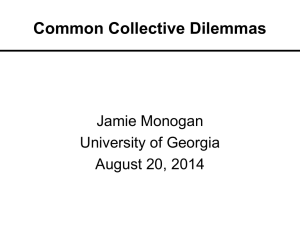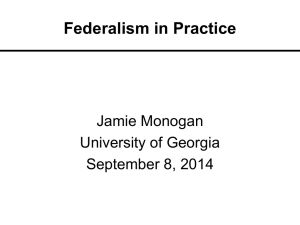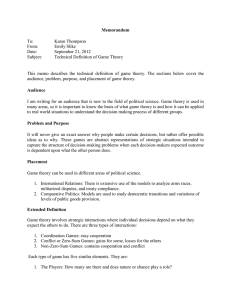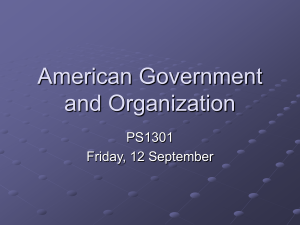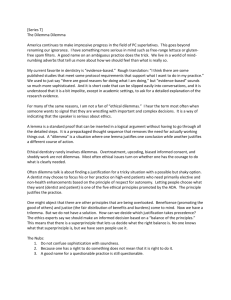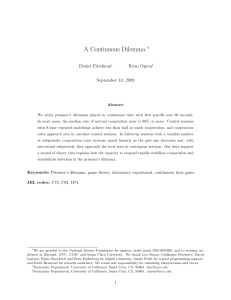2 - Dipartimento di Economia - Università degli Studi di Parma
advertisement
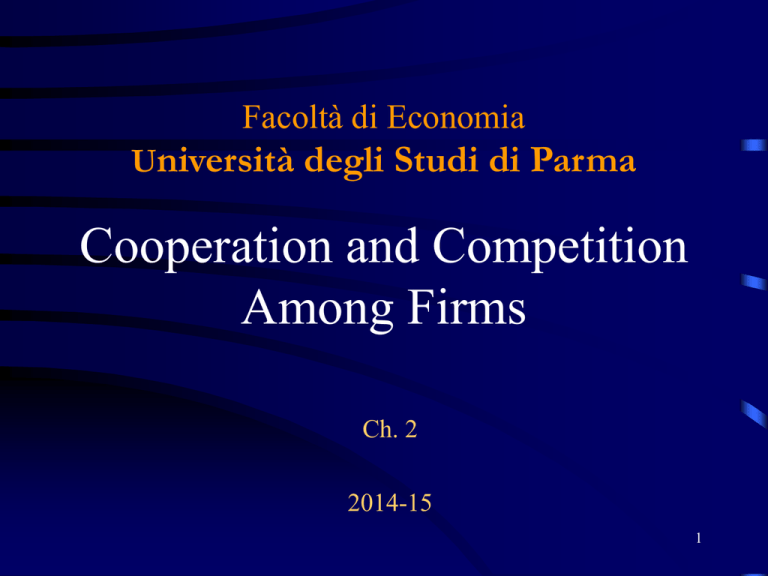
Facoltà di Economia
Università degli Studi di Parma
Cooperation and Competition
Among Firms
Ch. 2
2014-15
1
Costs of Cooperation
2
Inequality (1)
• Collective action is chosen by rational agents
when collective benefit (Bc) for each agent
(Bc/n=Bca) is higher than benefit from individual
action (Bia):
Bca>Bia
(1)
3
Costo dell’azione individuale
(Singolo agente/impresa)
• Interdipendenza: No
• Coordinazione attraverso: Prezzo/ Contratti/
Mercato
• Costi: Costi transazionali
4
Costi della Cooperazione
• Interdependence: High
• Coordination by : Administrative structure /
Information exchange/ Planning and monitoring/
Incentive and sactioning mechanisms/Enforcing
the rules/ Checking opportunist behaviour
• Costs: Regulation cost /Coordination costs
5
Costs of cooperation
• Interdependence: High
• Coordination by : Administrative structure /
Information exchange/ Planning and monitoring/
Incentive and sactioning mechanisms/Enforcing
the rules/ Checking opportunist behaviour
• Costs: Regulation cost /Coordination costs
6
Costs of cooperation
• Interdependence: High
• Coordination by : Administrative structure /
Information exchange/ Planning and monitoring/
Incentive and sactioning mechanisms/Enforcing
the rules/ Checking opportunist behaviour
• Costs: Regulation cost /Coordination costs
7
Inequality (2)
(Bca-(Cc+Cr))>(Bia-Ct)
with Cc, Cr>0 ; Ct0
where
Cc= Coordination costs
Cr= Regulation costs
Ct= Transaction costs
8
Regulation Costs
Set up of incentive and sactioning mechanisms
Checking opportunist behaviour
Enforcing the rules
9
Invisible Hand
•
• Rational (self-interested, opportunistic or not ) individuals,
who maximize their utility, increase the collective
aggregate welfare of the group
•
A. Smith (WoN): “…. he intends only his own security; and by directing that
industry in such a manner as its produce may be of the greatest value, he
intends only his own gain, and he is in this, as in many other cases, led by an
invisible hand to promote an end which was no part of his intention. Nor is it
always the worse for the society that it was not part of it. By pursuing his own
interest he frequently promotes that of the society more effectually than when
he really intends to promote it. “
10
Social dilemmas
Rational individuals, who maximize their
utility, may decrease not only the collective
welfare, but also their own individual
utility.
.
11
The Tragedy of the Commons
Hardin (1968) “ The Tragedy of the Commons”:
“The tragedy of the commons develops in this way.
Picture a pasture open to all. It is to be expected that
each herdsman will try to keep as many cattle as
possible on the commons. Such an arrangement may
work reasonably satisfactorily for centuries because
tribal wars, poaching, and disease keep the numbers
of both man and beast well below the carrying capacity
of the land. Finally, however, comes the day of
reckoning, that is, the day when the long-desired goal
of social stability becomes a reality. At this point, the
inherent logic of the commons remorselessly generates
tragedy.
The Tragedy of the Commons
As a rational being, each herdsman seeks to maximize
his gain. Explicitly or implicitly, more or less
consciously, he asks, "What is the utility to me of
adding one more animal to my herd?" This utility has
one negative and one positive component.
1. The positive component is a function of the increment
of one animal. Since the herdsman receives all
the proceeds from the sale of the additional animal,
the positive utility is nearly + 1.
2. The negative component is a function of the additional
overgrazing created by one more animal.
Since, however, the effects of overgrazing are shared
by all the herdsmen,the negative utility for any particular decisionmaking
herdsman is only a fraction of – 1
The Tragedy of the Commons
Adding together the component partial utilities, the
rational herdsman concludes that the only sensible
course for him to pursue is to add another animal to
his herd. And another.... But this is the conclusion
reached by each and every rational herdsman sharing
a commons. Therein is the tragedy. Each man is
locked into a system that compels him to increase his
herd without limit -- in a world that is limited. Ruin is
the destination toward which all men rush, each pursuing
his own best interest in a society that believes
in the freedom of the commons. Freedom in a commons
brings ruin to all”
• Hardin:
• http://www.youtube.com/watch?v=L8gAMFTAt2M
• Glass:
• http://www.youtube.com/watch?v=lwaNZgY9PCQ&feature=related
• Ostrom:
• http://www.youtube.com/watch?v=D1xwV2UDPAg
Social dilemmas
Rational individuals, who maximize their
utility, may decrease not only the collective
welfare, but also their own individual
utility.
(The source of social dilemmas is selfregarding
rationality
as
well
as
opportunism)
.
16
Social dilemmas
“Social
dilemmas are situations in which individual
rationality leads to collective irrationality. That is,
individually reasonable behavior leads to a situation in
which everyone is worse off than they might have been
otherwise. Many of the most challenging problems we
face, from the interpersonal to the international, are at their
core social dilemmas” (Kollock 1998).
17
Examples of social dilemmas
•
•
•
•
•
Supply of public goods
Exploitation of technological externalities
Collusion
Exploitation common pooled resources,
ecc.
18
The structure of social dilemmas:
the prisoner’s dilemma
19
The cartel
Firm F1 and F2 are part of a cartel of
producers. Payoff of different course of
action are perfectly known by the parties
20
Fearing the intervention of the antitrust
authoritiy, they give up to the mechanism of
exchange of information that until then had
ensured the coordination of their choices in
terms of output (or price) supplied on the
market.
21
Alternatives:
cooperate (continuing with the cartel, share
the monopoly profits);
defect (exiting the cartel, lower prices,
increase their market share and enhance
profits at the expense of the other firm).
22
Outcome 1
Both companies cooperate, and their profits
are equal to 4 (upper left quadrant)
23
Cooperation
F2
C
C
D
4,4
F1
D
24
Cooperation
F2
C
C
D
4,4
F1
D
25
Outcome 2
Firm F1 defects, while F2 cooperates. F1 obtains
profits equal to 8 and F2 equal to 0 (lower left
quadrant)
26
Defection of F1
F2
C
D
C
F1
D
8,0
27
Defection of F1
F2
C
D
C
F1
D
8,0
28
Outcome 3
Firm F2 defects, while F1 cooperates. F2 obtains
profits equal to 8 and F1 equal to 0 (upper right
quadrant)
29
Defection of F2
F2
C
C
D
0.8
F1
D
30
Outcome 4
Both firms defect and get profits equal to 2 (lower
right quadrant)
31
Defection of F1 and F2
F2
C
D
C
F1
D
2.2
32
Prisoner’s dilemma
F2
C
D
C
4,4
0,8
D
8,0
2.2
F1
33
Comparison between payoffs
F1 compares his own payoff to F2’s choices.
34
Prisoner’s dilemma
F2
C
D
C
4,4
0,8
D
8,0
2.2
F1
35
If F2 cooperates, the rational choice for F1 will be:
F2
C
D
C
4,4
0,8
D
8,0
2.2
F1
36
If F2 defects, the rational choice for F1 will be
F2
C
D
C
4,4
0,8
D
8,0
2,2
F1
37
F2 compares his own payoff to F1’s choices
38
Prisoner’s dilemma
F2
C
D
C
4,4
0,8
D
8,0
2.2
F1
39
If F1 cooperates, the best choice for F1 will be:
F2
C
D
C
4,4
0,8
D
8,0
2,2
F1
40
If F1 defects, the best choice for F1 will be:
F2
C
D
C
4,4
0,8
D
8,0
2,2
F1
41
Selected Payoff :
F2
C
D
C
4,4
0,8
D
8,0
2,2
F1
42
Considering it likely that the
counterpart intends to maximize its
benefit, both firms decide to defect in
order to minimize their losses
F2
C
D
C
4,4
0,8
D
8,0
2,2
F1
43
Individually rational choices lead
to collectively and individually
irrational outcomes.
(D,D=2,2<C,C=4,4)
44
• http://www.youtube.com/watch?v=X0_RoPXI4UA
•
https://www.youtube.com/watch?v=QYg8khfc9Fs
•
http://www.youtube.com/watch?v=IotsMu1J8fA&feature=player_detailpage
• Game Simulator
• http://www.gametheory.net/Mike/applets/NormalForm/
Prisoner’s dilemma
F2
C
D
C
4,4
0,8
D
8,0
2.2
F1
47
Generalization
R = “Reward”for mutual cooperation;
P = “Punishment”for mutual defection;
T = benefit from defection when the other cooperates
(“Temptation to defect”);
S = Benefit from cooperation when the other defects
(Sucker’s payoff)
F2
C
D
C
R,R
S,T
D
T,S
P,P
F1
48
Basic Assumption of Prisoner’s
Dilemma
T>R>P>S
(8>4>2>0)
49
Violations of assumptions
• If R = P, joint defection (P, P) shows no
conflict between individual rationality and
collective rationality;
.
50
Prisoner’s dilemma
F2
C
D
C
4,4
0,8
D
8,0
4,4
F1
51
Prisoner’s dilemma
F2
C
D
C
4,4
0,8
D
8,0
4,4
F1
52
Violations of assumptions
• If T = R, there will be no incentive to defect;
.
53
Prisoner’s dilemma
F2
C
D
C
8,8
0,8
D
8,0
2.2
F1
54
Prisoner’s dilemma
F2
C
D
C
8,8
0,8
D
8,0
2.2
F1
55
Violations of assumptions
• If P = S there will be more then one
equilibrium and the final outcome remains
unknown.
56
Prisoner’s dilemma
F2
C
D
C
4,4
2,8
D
8,2
2.2
F1
57
Prisoner’s dilemma
F2
C
D
C
4,4
2,8
D
8,2
2.2
F1
58
Cooperation
and the payoff structure
59
The level of payoff
(Experimental economics)
• The higher the prize (R), the greater the likelihood that
agents will continue to cooperate;
• The higher the value of the payoff of the punishment for
mutual defection (P), the greater the likelihood that agents
defect during the game;
60
• Where an agent defects and the other cooperates (C, D
or D, C):
• the lower (S) is, the greater the probability that the
cooperator will defect in the next round of the game;
• the greater (T) is, the greater the likelihood that the
defector will continue to defect.
61
Impact of the payoff structure
• (T-R), p(c)
• (R-P), p(c)
• (P-S), p(d)
62
K (Cooperation) Index
K=(R-P)/(T-S)
(Rapoport 1967)
63
Cooperation
and the Role of Communication
64
Communication and the likelihood
of cooperation
In a game theory context:
no effect
65
Communication and the likelihood
of cooperation
In an experimental economics context:
Dawes, McTavish and Shaklee (1977):
a) No communication among interacting agents;
b) Communication on the characteristics of the
players and issues not directly connected to the
game;
c) Communication on issues relevant to the game;
d) Notification of intention of the agents without
binding commitments.
66
Communication and the likelihood
of cooperation
Cooperation rate of A=B=28
Cooperation rate of C=D=68.
67
Explanation
Effects of communication :
1) interpersonal trust;
2) humanization of the group
3) individual identity;
4) understanding of the game;
5) collective identity of the group;
6) public commitments
on cooperation rate
68
Cooperation
and the Group Size
(Number of Participants)
69
Cooperation and the Group Size
“Too many cooks spoil the broth”
70
Cooperation and the Group Size
“Too many cooks spoil the broth”
In a game theory context: no effect
71
The Prisoner’s Dilemma
from 2 to N agents
B
C
D
C 3/2, 3/2 1/2, 2
A
D
2, 1/2
1, 1
72
Payoff Matrix
No. of
No. Of
Cooperators Defectors
Cooperators’
Payoff
Fedectors’
Payoff
3
0
3
-
2
1
2
4
1
2
1
3
0
3
-
2
73
Likelihood of Cooperation and Group Size
P(c)
2
6
10
No. agents
74
Interpretative hypotheses of the (inverse)
relationship between group size and
willingness to cooperation
• Bad apples
75
Interpretative hypotheses of the (inverse)
relationship between group size and
willingness to cooperation
• Bad apples
• Interpersonal control
• Hume's Treatise:
• “Two neighbors may agree to drain a meadow, which they possess in
common; because 'tis easy for them to know each others mind, and each
may perceive that the immediate consequence of failing in his part is
the abandoning of the whole project. But 'tis difficult, and indeed
impossible, that a thousand persons shou'd agree in any such action ...”
76
Interpretative hypotheses of the (inverse)
relationship between group size and
willingness to cooperation
• Bad apples
• Interpersonal control
• Effectiveness of individual action
77
Social Dilemmas and
Regulation Costs
At the firm level:
• Set up of internal mechanism of detecting opportunism
• Writing contractual safeguards
• Legal protection of industrial knowledge
• Conflict prevention and management (Hostages)
• Sanctioning procedures
• Modify the payoff structure
• Set up and management of government devices
• etc.
Inequality (2)
Cr))>(B
(Bca-(Cc+
ia-Ct)
with Cc, Cr>0 ; Ct0
where
Cc= Coordination costs
Cr= Regulation costs
Ct= Transaction costs
79
Coordination Costs
80
Coordination Game (1)
Battle of the Sexes
Paola
Paolo
F
B
F
3, 1
0, 0
B
0, 0
1, 3
F=Football Match
B=Ballet
81
Coordination Game (1)
Battle of the Sexes
Paola
B
F
F
3, 1
0, 0
B
0, 0
1, 3
Paolo
F=Football Match
B=Ballet
82
Dimensions of the coordination
problems:
1) the constraints that agents assume, by contract or
by convention, to avoid conflicting decisions.
2) the procedures to identify a single equilibrium
solution among different alternatives;
83
Main characteristics of the coordination
problems (in comparison with PD) :
1) Information vs opportunism;
2) More than one equilibrium.
84
Coordination Game (2)
Costs related to:
•
•
•
•
•
•
information investment,
knowledge transfer,
comparison between feasible alternatives;
singling out the best course of action
negotiating investments ;
adjustment of individual conduct to the general
course of action (modifying individual plans,
accomplishing time and space constraints
(synchronization))
85
Coordination Game (2)
A2
P
M
P
3, 3
2, 2
M
2, 2
3, 3
A1
86
Coordination Game (2)
A2
P
M
P
3, 3
2, 2
M
2, 2
3, 3
A1
87
Coordination Game (2)
A2
P
M
P
3, 3
2, 2
M
2, 2
3, 3
A1
88
Coordination Game (2)
A2
P
M
P
3, 3
2, 2
M
2, 2
3, 3
A1
89
Coordination Game (2)
• https://www.youtube.com/watch?v=2sT_zaofuuE
Coordination Game (3)
Stag Hunt Game (Assurance Game)
Jean-Jacques Rousseau
A2
Stag
Hare
Stag
2, 2
0, 1.5
Hare
1.5, 0
1, 1
A1
http://www.youtube.com/watch?v=C85jOlRt_88
91
Rousseau in A Discourse on Inequality:
“If it was a matter of hunting a deer, everyone well
realized that he must remain faithful to his post; but if a
hare happened to pass within reach of one of them, we
cannot doubt that he would have gone off in pursuit of it
without scruple..."
92
Coordination Game (3)
Stag Hunt Game (Assurance Game)
Jean-Jacques Rousseau
A2
Stag
Hare
Stag
2, 2
0, 1.5
Hare
1.5, 0
1, 1
A1
http://www.youtube.com/watch?v=C85jOlRt_88
93
Coordination Game (3)
Stag Hunt Game (Assurance Game)
A2
Stag
Hare
Stag
2, 2
0, 1.5
Hare
1.5, 0
1, 1
A1
94
Coordination Game (4)
A2
T
M
T
4, 3
2, 1
M
2, 1
3, 4
A1
95
Coordination Game (3)
A2
T
M
T
4, 3
2, 1
M
2, 1
3, 4
A1
96
Coordination Difficulties
(van Huyck, Battalio and Beil 1990)
Minimun value of chosen X
1
Chosen X
by Agent N
7
6
5
4
3
2
1
7
1,3
1,1
0,9
0,7
0,5
0,3
0,1
6
-
1,2
1,0
0,8
0,6
0,4
0,2
5
-
-
1,1
0,9
0,7
0,5
0,3
4
-
-
-
1,0
0,8
0,6
0,4
3
-
-
-
-
0,9
0,7
0,5
2
-
-
-
-
-
0,8
0,6
1
-
-
-
-
-
-
0,7
97
Dimensions of the coordination
problems:
1) the constraints that agents assume, by contract or
by convention, to avoid conflicting decisions.
2) the procedures to identify a single equilibrium
solution among different alternatives;
3) the containment of the risk that, owing to
strategic uncertainty, suboptimal equilibria will
be chosen.
98
Ranking of the importance
of specific factors for strategic alliances
Clearly understood roles
Communication between partners
Clearly defined objectives
Relationships building
Thorough planning
Frequent performance feedback
Clear payback timelines
Integration of information system
(1) Assumption of imperfect information
If the economic and technological content of
the goods to be produced is not known to the
agents, there emerges a new constraint to
collective action: before starting the production
of the collective good, agents must decide
which among different alternatives should be
taken.
100
(1) Assumption of imperfect information
Most of the projects carried out in the present have
only partial similarities with those carried out in
the past
(Different technology, different availability of
resources, changes in individual preferences,
group size, etc.).
101
(1) Assumption of imperfect information
Hence obstacles to collective action
consist of information and decision
costs that individual agents have to
sustain to identify which goods should
be produced
as well as uncertainty on the
distribution of net benefits
102
(2)Multipliplicity of equilibria
Collective action has its origin in the strategic
complementarity which exists between the
individuals who take part ('individual agents are
more productive the higher the production level of
other agents' (Cooper and Johri, 1996).
103
C
CCoord
AC
N
C
CC
AC
N2
N
C
CC
AC
N2 N3
N
C
CC
AC
N2± N3
N
C
TC
CC
AC
N2± N3
N
(2)Multipliplicity of equilibria
The existence of complementarity, on the
one hand, determines incentive to
collective action and justifies the greater
efficiency of the choice of cooperative
rather than individual action. On the other
hand, it is the source of a multiplicity of
equilibria.
In fact, as we will see, the greater the size
of the group of participants, the greater the
value of its contribution and the more
alternative technologies available, the
109
wider the range of possible solutions.
110
111
112
113
114
115
116
117
The starting of collective action
• The goods to be made become known only after
the agents have organized the alternatives and
have managed to identify the optimum solution (of
the many possible ones).
• The equilibrium selected will determine the
amount of the individual investment (or its cost),
the size of the group of participants and the
technology.
• Only then will possible sanctions for nonobservance of the agreement be decided and the
production process start.
The starting of collective action
• Even before control of the risks of free riding, collective
production of a good appears to be influenced by the costs
of the search for the most efficient solution and the
alignment of individual agents' plans to a single general
plan (costs of co-ordination).
The beginning of collective action
• In logical time (and often in historical time) the failure of
collective action depends firstly on co-ordination failure
and secondly on benefit redistribution conflict.
• The problem of co-ordination is met before the control of
opportunism and the seriousness of the problem appears to
be independent of the entity of the second.
• In fact, if we had significant co-ordination costs and
absence of opportunism, the level of co-ordination costs
would nevertheless remain high and the likelihood of nonproduction would also be significant.
Types of coordination costs
(information and decision making costs)
• Negotiating costs
• Synchronization costs
• Selection costs
121
Negotiating costs
• Known
Synchronization costs
Cost of formalizing a convergent and simultaneous decision.
Arising from:
• degree of anomie
• informational barriers (eg. distortions in the
communication, ambiguity in the signals, physical
distance);
• division of labor and role specialization.
123
Selection costs
Costs of identifying the optimal equilibrium
Arising from:
•
•
•
acquisition and transfer of information between the relevant
players;
adaptation of knowledge possessed by the players to the skills
useful for the assessment of individual plans;
identification and sorting workable options (equilibria).
124
Inequality (2)
(Bca-(Cc+Cr))>(Bia-Ct)
with Cc, Cr>0 ; Ct0
where
Cc= Coordination costs
Cr= Regulation costs
Ct= Transaction costs
125
Check List
Expected Gross Benefits of ……………………………
Individual Firm
Economie of Scale
Economies of Scope
Economies of Specialization
Reduction of Transaction Costs
Risk sharing
Collusion Payoffs
Internalization of Esternalities
Exploitation of Resource
Complementarity
Lower Market Incompleteness
0
1
3
5
Check List
Expected Gross Benefits of ……………………………
Interfirm Cooperation
Economie of Scale
Economies of Scope
Economies of Specialization
Reduction of Transaction Costs
Risk sharing
Collusion Payoffs
Internalization of Esternalities
Exploitation of Resource
Complementarity
Lower Market Incompleteness
0
1
3
5
Check List
Expected Gross Benefits of ……………………………
Acquisition & Merger
Economie of Scale
Economies of Scope
Economies of Specialization
Reduction of Transaction Costs
Risk sharing
Collusion Payoffs
Internalization of Esternalities
Exploitation of Resource
Complementarity
Lower Market Incompleteness
0
1
3
5
Check List
Costs of ……………………………
Individual Firm
Transaction costs : Singling out the
minimun price in the market
Transaction costs : Negotiating the
safeguards
Transaction costs : Writing a contract
0
1
3
5
Check List
Costs of ……………………………
Interfirm Cooperation
Regulation costs
Negotiating costs
Synchronization costs
Selection costs
0
1
3
5
Check List
Costs of ……………………………
Acquisition & Merger
Transaction costs : Singling out the
minimun price in the market
Transaction costs : Negotiating the
safeguards
Transaction costs : Writing a contract
0
1
3
5
